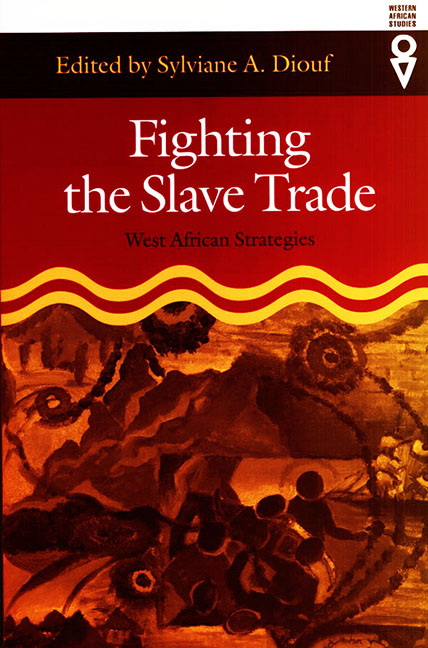Book contents
- Frontmatter
- Contents
- Preface
- Introduction
- PART 1 DEFENSIVE STRATEGIES
- 1 Lacustrine Villages in South Benin as Refuges from the Slave Trade
- 2 Slave-Raiding and Defensive Systems South of Lake Chad from the Sixteenth to the Nineteenth Century
- 3 The Myth of Inevitability and Invincibility: Resistance to Slavers and the Slave Trade in Central Africa, 1850–1910
- 4 The Impact of the Slave Trade on Cayor and Baol: Mutations in Habitat and Land Occupancy
- 5 Defensive Strategies: Wasulu, Masina, and the Slave Trade
- PART 2 PROTECTIVE STRATEGIES
- PART 3 OFFENSIVE STRATEGIES
- Epilogue: Memory as Resistance: Identity and the Contested History of Slavery in Southeastern Nigeria, an Oral History Project
- Contributors
- Index
3 - The Myth of Inevitability and Invincibility: Resistance to Slavers and the Slave Trade in Central Africa, 1850–1910
from PART 1 - DEFENSIVE STRATEGIES
Published online by Cambridge University Press: 30 August 2017
- Frontmatter
- Contents
- Preface
- Introduction
- PART 1 DEFENSIVE STRATEGIES
- 1 Lacustrine Villages in South Benin as Refuges from the Slave Trade
- 2 Slave-Raiding and Defensive Systems South of Lake Chad from the Sixteenth to the Nineteenth Century
- 3 The Myth of Inevitability and Invincibility: Resistance to Slavers and the Slave Trade in Central Africa, 1850–1910
- 4 The Impact of the Slave Trade on Cayor and Baol: Mutations in Habitat and Land Occupancy
- 5 Defensive Strategies: Wasulu, Masina, and the Slave Trade
- PART 2 PROTECTIVE STRATEGIES
- PART 3 OFFENSIVE STRATEGIES
- Epilogue: Memory as Resistance: Identity and the Contested History of Slavery in Southeastern Nigeria, an Oral History Project
- Contributors
- Index
Summary
ALTHOUGH MYTHOLOGIES SURROUNDING slave raids and the slave trade in Africa would have it that slavers were all but invincible, enjoying superiority in numbers and technology, the reality for both the Atlantic and Muslim commerce was often otherwise. African men and women employed a variety of strategies to resist attacks of slave raiders and later sale by slave merchants. Oral testimonies collected in north-central Africa in the 1970s, as well as travel literature from the nineteenth and twentienth centuries and early French colonial records, afford glimpses into the ways that peoples such as the Sara in today's southern Chad, and the Banda and Manza in today's Central African Republic (CAR) resisted the attacks of raiders: from the kingdoms of Bagirmi and Wadai in the Chad basin to the north in the 1870s, from the Khartoumers and their successors from the Nile basin to the east around the same time, and later in the century from bands of brigands associated with warlord Rabih Fadl-Allah and his client Muhammad al-Sanusi in the region itself. Indeed al-Sanusi became “sultan” of Dar al-Kuti, one of the last major slave-exporting states in north-central Africa—before the tragic resurgence of slave raiding and slave trading in the area in the late twentieth century (Rone 1995; Weber 1999).
This essay explores the varieties and strategies of resistance to Muslim slave raiding and the Muslim slave trade in north-central Africa. Ranging from physical resistance that was perhaps more effective than the stereotypes of raiding usually suggest, to the adoption of new building styles, settlement patterns, and crops, and to strategies of hiding and flight, the peoples of this part of Africa attempted to protect themselves, their families, and their neighbors from the twin scourges of slave raiders and slave traders. These efforts were by no means always successful, but neither were they uniformly ineffective. Before examining the ways that individuals and groups resisted the depredations of raiders, however, it is necessary to contextualize and historicize the evolution of the slaving frontiers in this part of Africa.
THE EXPANSION OF MUSLIM SLAVING FRONTIERS IN NORTH-CENTRAL AFRICA
The broad chronology and geography of shifting Muslim slaving frontiers in north-central Africa are by now reasonably well known (Burnham 1980; Cordell 1979, 1983, 1985a,b, 1988; Dampierre 1967, 1983; Santandrea 1964, 1981; Sikainga 1991).
- Type
- Chapter
- Information
- Fighting the Slave TradeWest African Strategies, pp. 31 - 49Publisher: Boydell & BrewerPrint publication year: 2004

